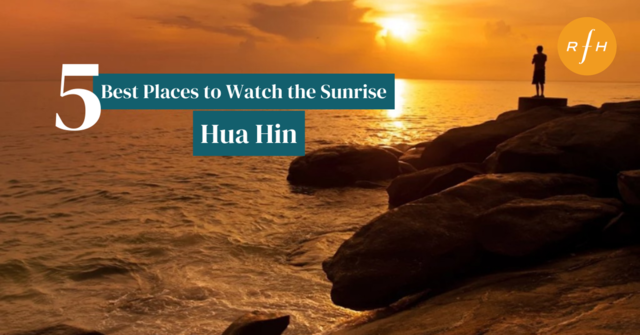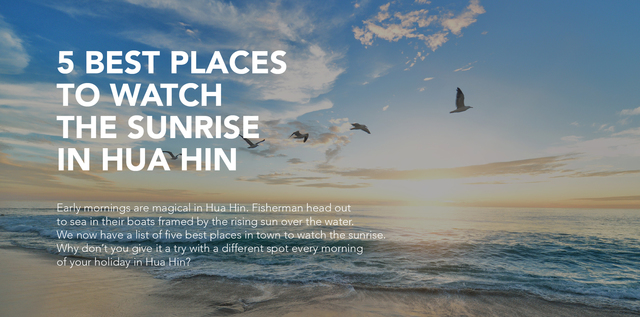Watching Over Hua Hin
May 17, 2019.
Tags: Hua hin
Two of the most iconic Buddhist temples in Thailand are located to the north and south of the town of Hua Hin and seem to stand watch over the beach-side town, ensuring its peacefulness and serenity.
The Buddhist temple called a 'Wat' in the Thai language is ubiquitous all across the country and has been going back about 700 years to the reign of King Ramkhamhaeng.
They are an essential facet of every small village and large city in the country and serve as both a community gathering place for birthday and marriage celebrations as well as a place to perform religious rites and make merit.
But to have two of the most visually dramatic Buddhist temples in the country watching over Hua Hin is truly a blessing for such a small, quiet town.
As always whenever you visit a Buddhist temple in Thailand, you must dress and act appropriately. Always cover your knees and shoulders. Take off your shoes before entering any structure and don’t point your feet toward Buddha. No public displays of affection and don’t smoke.
Wat Khao Takiap
Wat Khao Takiap atop “Chopsticks Hill” is one of the most notable features of Hua Hin and certainly one of the most photographed.
The Wat occupies various areas around and on the 272-metre hill that is mostly formed from large, limestone boulders. The hill's location on a small peninsula that juts out into the Gulf of Thailand on the south end of town makes it one of the best spots for panoramic photos of the town and beachfront to the north.
When you first approach the hill from the ocean-side, you’ll notice a 20-metre, golden statue of Buddha facing the water, with its arms outstretched. This statue is to bless the fishing boats that set out from Hua Hin to ply their trade on the waters of the gulf.
The main feature of the Wat is the beautiful, white shrine that sits halfway up the hill. Taking its inspiration from the lotus leaf, as most traditional Thai architecture does, the soft and graceful curves, accented in blue, red and gold-leaf and the high spire of the shrine are one of Hua Hin’s most recognisable landmarks. The shrine can be seen from all along Hua Hin Beach.
Adventurous souls can reach the shrine by climbing the 80 or so steep steps from the bottom of the hill to the shrine, or you have the option of driving up as well to a carpark next to the shrine that has the added features of a whimsical variety of Buddhist-themed statues and even some statues of dinosaurs.
There is also a snack shop by the carpark, and this has attracted some extra guests to the Wat. Be prepared to be greeted by literally hundreds of macaque monkeys. Be sure to keep all your bags and other personal property close to your body and don’t walk around with food you don’t want to share with the monkeys. They are not really dangerous, but they can get aggressive, pushy and grabby when food is present.
A trip out to Wat Khao Takiap is a pleasant way to spend a morning, see Hua Hin from a different perspective and get some spectacular pictures of the coastline.
Khao Luang Cave
The similarities between Wat Khao Takiap and Khao Luang Cave are confined to their elevation. They both tower above the surrounding countryside, and both look over Hua Hin, but they both offer completely different experiences.
Where Wat Khao Takiap offers outward-looking panoramic views, Khao Luang Cave offers a majestic and cathedral-like, natural limestone shrine within the interior of a cave. This is a temple contained entirely within a mountain, with a hole in the hill that allows shafts of dramatic sunlight to penetrate to the cave floor.
Khao Luang Cave is located in the 100-metre high, Khao Luang Hill. The cave is home to about 170 images and statues of Buddha which have contributed to its visual appeal and popularity.
King Mongkut (Rama IV), used to use the cave as a place to meditate and study Buddhism. He commissioned a number of the statues that grace the shrine. His successor, King Chulalongkorn, commissioned a 4-metre, reclining statue of Buddha that he placed in the cave to honour his predecessors, Rama III and Rama IV.
Upon entering the cave, you're struck by the natural splendour of the high-ceilings, stalactites and the many iconic statues of Buddha. The air is hushed and sandalwood and incense perfume the still air. Photography is allowed, so you're welcome to take pictures.
Outside the cave, you will, once again, encounter hordes of macaque monkeys. There is a walkway that you must use to ascend and descend from the cave, and several stalls outside the cave sell food and drinks for both the tourists and the monkeys.
Choose Rentals for The Holidays When You Visit Hua Hin
These Buddhist temples are both well worth a visit when you come to Hua Hin for your holiday. But whether you want to stay on the north or south end of Hua Hin, Rentals for the Holidays has plenty of quality accommodations all over town for you to choose from. Next time you visit Hua Hin, contact Rentals for the Holidays.


